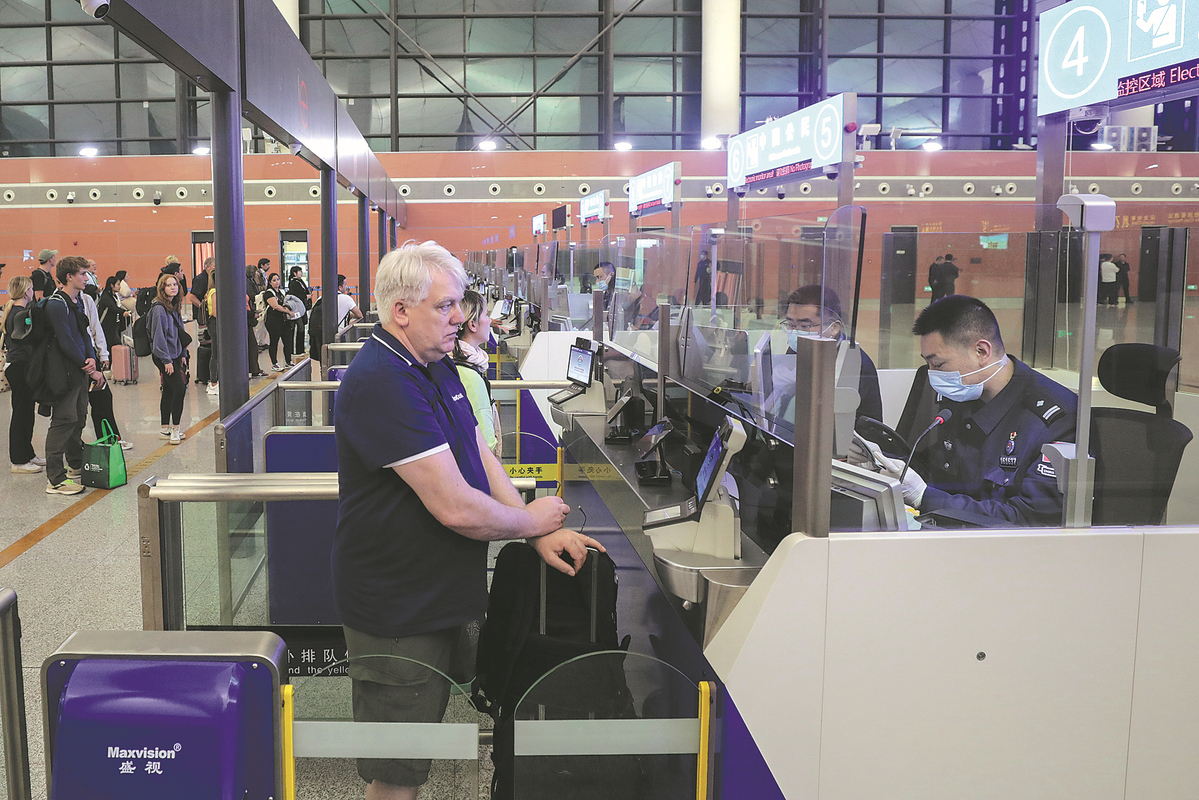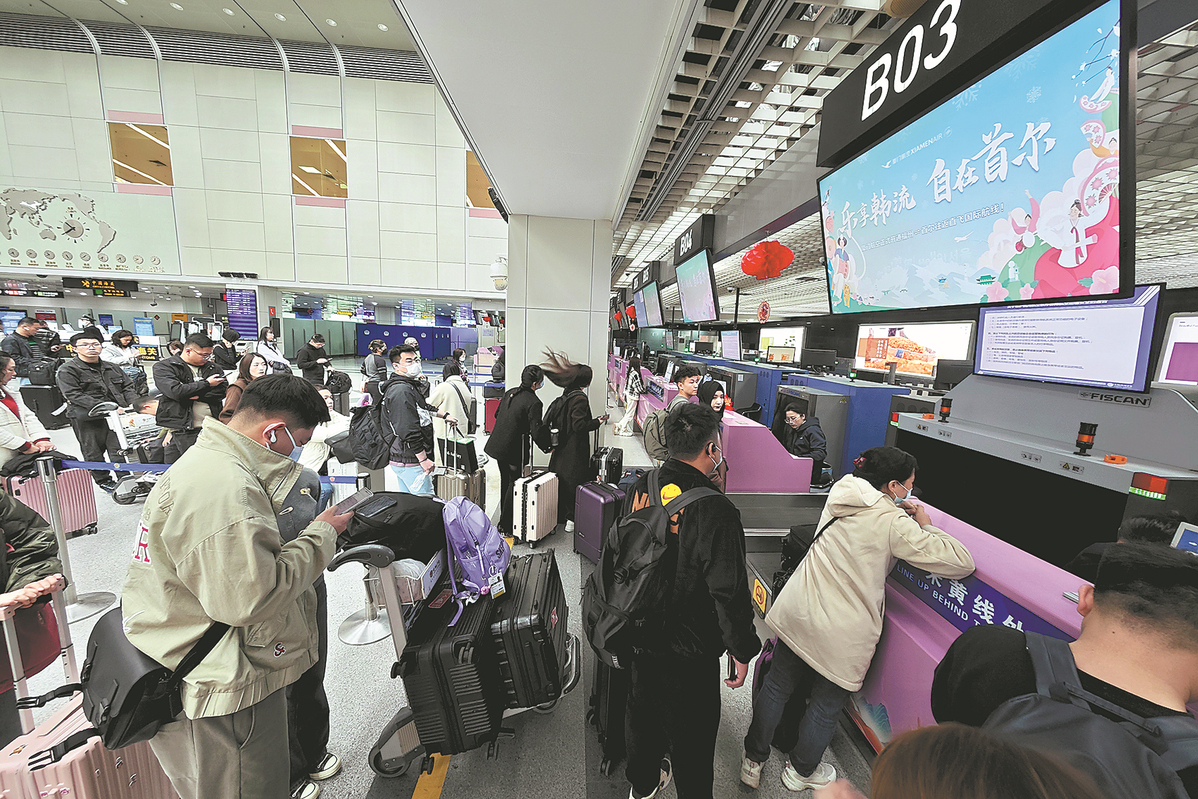Air travel emerges from turbulence of pandemic

A passenger from Fuzhou, Fujian province poses for a photo with greeters at the Kota Kinabalu International Airport, in the Malaysian state of Sabah, on June 27, when Xiamen Airlines resumed its Fuzhou-Kota Kinabalu route. (CHENG YIHENG/XINHUA)
Fueled by a boom in Chinese travelers visiting Japan this summer, extra direct flights have been launched between the two countries — including to niche destinations — with more flights expected to be added to satisfy the growing demand, industry players said.
The rush to visit Japan has been fueled by Chinese students taking their summer vacations, and the favorable exchange rate with the Japanese yen, making hotels, meals, and attractions more affordable.
The resurgence of Japan as a travel destination for Chinese travelers also follows the easing of COVID-19 restrictions.
In the first half of this year, a record 17.78 million international travelers visited Japan. During the same period in 2019, before the pandemic, the number was 16.63 million, according to the Japan National Tourism Organization.
The main sources of international visitors were South Korea, China and the United States, the organization said.
The strong outbound travel demand has prompted more Chinese airlines to launch new direct flights and increase the frequencies of current flights to Japanese cities, including smaller ones.
Shanghai-based private budget carrier, Spring Airlines, operates direct flights connecting Shanghai, and Takamatsu and Saga in Japan. The flight capacity on the two routes has exceeded 90 percent recently, with most of the passengers Chinese leisure travelers, the airline said.
The carrier recently increased its number of daily round-trip flights from Shanghai to Osaka to five, up from two last year, after adding extra flights to Japan ahead of the peak season.
"Before the summer, we launched new flights connecting Shanghai with Fukuoka and Okinawa," said Mao Yi, head of communications at Spring Airlines.
"Still, the China-Japan routes of international flights have not fully recovered from the pandemic. We will do our best to resume more international flights soon, and provide passengers with more choices," Mao said.
Shanghai-based China Eastern Airlines operates direct flights connecting Shanghai Pudong International Airport with smaller Japanese cities such as Shizuoka, Okayama and Komatsu, in addition to direct flights to major Japanese cities.
Juneyao Airlines, another Shanghai-based Chinese private carrier, operates direct flights connecting Shanghai to Sapporo and Hokkaido.
"The main travel demand for smaller Japanese cities comes from leisure travelers," said Lin Zhijie, a civil aviation industry analyst and writer for Carnoc, a major civil aviation website.
"Niche Japanese cities boast rich tourism resources and different features, and those smaller Japanese cities are equipped with airports, making it more convenient to launch direct flights. The total number of available flights connecting China and Japan still can't meet the travel demand between the two countries," Lin said, adding this includes business as well as leisure travel demand.
Currently, the main bottleneck is the ground support capability in Japan. There are hopes within the industry that more flights will be launched in the near future to further meet the expanding demand.

Passengers go through border inspection at the Taoxian International Airport in Shenyang, Liaoning province, on April 24. China Southern Airlines opened a new passenger air route linking Shenyang with Frankfurt, making it the first direct regular route from Northeastern China to Germany opened by a domestic airline. (PHOTO/XINHUA)
More fuel needed
A growing number of flights to Japan have even led to a shortage of aviation fuel in the country. Tokyo's Narita International Airport said in late June that six carriers in Asia hoped to add new flights or increase flight frequencies to the airport. However, due to a shortage of aviation fuel, the airport had to postpone the plans.
Some smaller airports such as Tokachi Obihiro Airport in Hokkaido, and Hiroshima Airport, have also experienced shortages of aviation fuel. Some flights operated by Asian carriers had to import their own fuel for round trips, Japanese media reported.
Qingdao in East China's Shandong province, has also seen the number of inbound and outbound passengers at Qingdao Jiaodong International Airport continue to rise this summer.
On July 25, Qingdao Airlines launched passenger flights connecting Qingdao and Osaka three times a week. And, on Aug 1, Shandong Airlines added another seven weekly round-trip flights connecting Qingdao and Osaka, taking the total number of direct flights connecting the two cities to 24 a week, covering different times of the day.
Qingdao also plans to launch more international flights to meet growing international travel demand, local airport representatives said.
In addition, a direct flight operated by China Eastern Airlines connecting Hefei, Anhui province, and Osaka, was launched on July 28. The route is expected to provide convenient services for passengers from Anhui and surrounding areas to travel to Japan, promoting economic, cultural, and tourism exchanges between the two regions, the carrier said.

A China Southern Airlines plane is seen at an airport. (Photo/China Daily)
Taking flight
China's air travel market has witnessed a strong recovery after the pandemic. In the first half of this year, China transported 350 million passengers by air domestically, growing 24 percent year-on-year. The figure was 9 percent above the pre-pandemic level in 2019, according to the Civil Aviation Administration of China.
The growth indicates that the country's air travel market has completely emerged from the shadow of the pandemic, and the sector is steadily returning to its natural growth level, the CAAC said.
Meanwhile, the number of international and regional air passengers in the first half of this year rebounded to 79 percent of the 2019 level. Travel demand between China and Europe, Japan, South Korea, and Singapore, in particular, has been strong, the CAAC said.
"This summer, popular international passenger routes continue to concentrate on traditional tourism markets such as Japan, South Korea, and Southeast Asian countries," said Xu Qing, a CAAC official.
"Driven by major events such as the Paris Olympic Games, there has been a significant increase in the number of flights from China to France. Besides, airlines have added more flights to countries such as Denmark, Hungary, and Greece," Xu said.
The CAAC said it will support Chinese and foreign airlines increase their capacity on international passenger routes, further boost the number of flights based on market conditions, and better meet the travel demand of passengers.
With multiple countries introducing favorable visa policies for Chinese travelers, along with China's visa-free policy for some foreign countries, China has seen a significant growth in the number of inbound and outbound passengers.
In the first six months of this year, 14.64 million foreign travelers visited China through various ports across the country, with the number surging 152.7 percent year-on-year, according to the National Immigration Administration.

Passengers boarding the Air China flight from Jeju to Beijing take photos in the check-in area at Jeju International Airport in South Korea on March 31, when the resumption ceremony of the Air China Beijing-Jeju route was held. (SUN YIRAN/XINHUA)
Among those, 8.54 million foreigners visited the country through visa-free entry, accounting for 52 percent of total entries. The administration projected that foreign travelers' enthusiasm for visiting China will keep growing in the second half of the year.
The air travel market in China has entered its summer peak season, and domestic airports are expected to handle 1.08 million takeoffs and landings, with the average number of daily flights 17,361, an increase of 13.87 percent compared with the 2019 pre-pandemic level, according to statistics compiled by Civil Aviation Data Analysis.
Chinese travelers have also shown greater interest in traveling abroad. In the first half of this year, China-Singapore round-trip flights accounted for 3.7 million passengers at Singapore's Changi Airport, or about 11 percent of the total passenger volume. The numbers exceeded, or approached, the pre-pandemic level seen in 2019 for five consecutive months, the airport said.
The numbers of passengers from Shanghai, Xiamen, Fujian province, and Kunming, Yunnan province, have been growing the fastest. The 30-day visa-free entry between China and Singapore, as well as the increase in flight capacities, has driven the passenger volumes between the two countries, the airport said.
The International Air Transport Association recently released global data for June. Total demand, measured in revenue passenger kilometers, was up 9.1 percent compared with June 2023. Total capacity, measured in available seat kilometers, was up 8.5 percent year-on-year, and the passenger load factor was 85 percent in June.
"Demand grew across all regions as the peak northern summer travel season began in June. And with overall capacity growth lagging demand, we saw a very strong average load factor of 85 percent achieved in both domestic and international operations," said Willie Walsh, IATA's director general.
"Operating with such high load factors is both good and challenging. It makes it even more important for all the stakeholders to operate with equal levels of efficiency to minimize delays and get travelers to their destinations on schedule," Walsh said.

Passengers check in at Fuzhou Changle International Airport on Jan 31, when the first direct international flight route between Fuzhou and Incheon Airport in Seoul, South Korea, was officially opened. (WANG DONGMING/CHINA NEWS SERVICE)
Impact of conflict
In addition to strong growth, a number of foreign carriers recently canceled their international flights that connect overseas cities with Chinese mainland cities and Hong Kong, as they had to reroute flights to bypass the airspaces of Russia, leading to increased flying time and higher fuel costs, the carriers said.
British carrier Virgin Atlantic announced in July that it would suspend its flights that connect Shanghai Pudong International Airport and London Heathrow Airport after operating the route for 25 years. The last round-trip flights will operate on Oct 25 and Oct 26.
As one of the foreign carriers that entered the China market the earliest, Virgin resumed Shanghai-London flights in May 2023 after a hiatus due to the COVID-19 pandemic. The decision to suspend the Shanghai-London route follows the suspension of Virgin's London-Hong Kong route in October 2022 after almost 30 years of operation.
Meanwhile, British Airways said it would temporarily cut the flight frequency of the London-Hong Kong route from two daily flights to one from Oct 27, as the inability to overfly Russia has led to surging operational costs.
British Airways resumed flights connecting London to Shanghai and Beijing last summer after the pandemic. The carrier currently runs daily flights between London and Shanghai, and four times a week to Beijing. The carrier will suspend its Beijing Daxing-London flight from Oct 26.
Currently, eight domestic carriers and two foreign carriers, British Airways and Virgin Atlantic, operate 18 China-UK routes. The Chinese carriers are Air China, China Eastern Airlines, China Southern Airlines, Hainan Airlines, Shenzhen Airlines, Tianjin Airlines, Capital Airlines, and Juneyao Airlines, according to Flight Master, a travel services platform in China.
The landscape of competition on the China-Europe air route has undergone significant changes after the pandemic, and the competitive advantage of Chinese carriers has become more prominent.
In the first half of this year, domestic airlines operated 72.2 percent of China-Europe flights, and foreign airlines operated 27.8 percent. Before the pandemic, there was not much difference in the share of such flights, when Chinese carriers made up 52.7 percent, and foreign airlines accounted for 47.3 percent, Flight Master found.
Photos
Related Stories
- Tourism booms in Shennongjia Forest District, C China's Hubei
- Beijing to introduce travel pass for foreign visitors
- Tropical island captivates foreign tourists amid "China Travel" boom
- Chinese hotel chains expand overseas operations
- Commentary: "China Travel" boom shows unyielding commitment to openness
- Visa-free policy boosts Chinese tourist arrivals by nearly 200 pct: Malaysian official
Copyright © 2024 People's Daily Online. All Rights Reserved.









